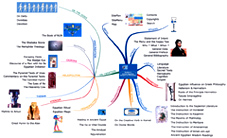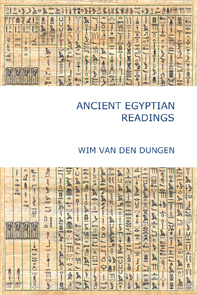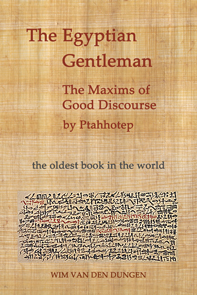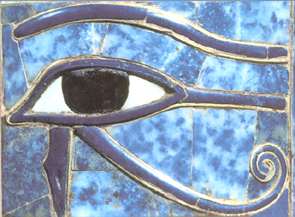|
This
section is devoted to six Egyptian wisdom-teachings, written between ca. 2500
and 1075 BCE.
The first three teachings (Hordedef, Kagemni & Ptahhotep) are
translated, annotated and discussed in a single paper, which also serves
as a general introduction to "maat", truth and justice and
"Maat", the goddess of the balance. The
Maxims
of Good Discourse
of Ptahhotep indeed remain the fundamental
treatise of this sapiental literature, born in scribal circles.
In Ancient Egypt,
"philosophy" was not a profession, nor a trade (as it would be
in the Greece of the errant Sophists teachers and pre-Socratic Eleatics). Hence, there
was no word for
"philosopher" (the lovers of wisdom, "sofia") in the
Greek sense (the first positive use of the word "philosopher"
has been attributed to Pythagoras and Anaximander). Wisdom was regarded as
something some people grew into as a result of obeying the
"natural" correct laws which regulated life. Their
conceptualization of these laws, although metaphorical, visual and
pluriform, shows that a constant appreciation of truth, justice and
integrity stood at the heart of it. These higher human values were at work
in the cosmos (in things as they are) and in human cultures (in things as
they ought to be), and Pharaoh was the best of the good examples.
That humans were able to turn their face and do "isefet" (evil)
willingly was forcefully rejected but indeed (already then) a daily fact
of life. To make tombs as well as to rob them was always a national sport.
Keeping Maât was a regulative ideal which constantly functioned as
a "moral eye" (cf. the white eye of undisrupted wellness). If
people lived as the creatures they truly were, Maât would always be
restored when out of balance and the good order would be able to
endure for ever. But it is precisely because hearts choose to go wrong,
that unbalance perpetuates & degenerates. Much later, bishop Augustine
of Hippo said the same using other words : the free will is only there to
sin ... (cf. my
Against the Free Will, 1999),
or : one's true will is not free, but neither is it restrained. Also in
Sufism
is this apparent : the word for "reality" and "truth"
is both "al-haq" (one of the Most Beautiful Names cherished by
Ibn'Arabî and his school).
As nobody was born wise, we see wisdom appear,
in the so-called "didactical literature" of the Instructions, as an exponent of the
didactical process of acquiring a just, sapiental perspective on life, i.e. the time of "follow-the-heart"
(Maxims on Good Discourse, Maxim 11). Wisdom was the best a non-royal aristocrat
or a common intellectual (priest, scribe) could
hope for. In the Instructions, we can see it at work as the law of
existence itself. Both the good discourse as the state of the hearer (who
should listen) were deemed essential.
Insofar as we relate philosophy to the overall metaphysical question of
the nature of the universe and humankind, Ancient Egyptian literature
reveals itself to be a very fertile ground. Besides the explicit presence of
wisdom in moral teachings such as this sapiental literature, we find philosophical strands,
elements & perspectives in
creation-texts, resurrection-texts, songs of praise (hymns), funerary
spells, tales, poetry, literature of despair & ante-scientifical texts
(medical, astronomical & mathematical papyri). These considerations
are always intermingled with the context at hand, but as soon as a broad
comparative horizon emerges, one can not deny that the Ancient Egyptians
had a
philosophical inclination, albeit in an ante-rational format. That this
"wisdom" was not the result of a free, independent rational dialogue should
trigger our interest to find out the silhouette of the Ancient Egyptian
sage. He is not a disputant, but one who listens and acts out truth and
justice.
It is likewise true that only in the "sapiental" genre,
wisdom-teachings (i.e. knowledge which makes wise) appeared in a narrative
format of their own and enjoyed a considerable popularity and historical
continuity. Although the extant record of the sapiental teachings is
slightly more extended than the usual instructions on papyrus (cf.
Brunner,
1997), I limited myself to the translation & hermeneutical study of
the following major, truly
native Egyptian wisdom-teachings, concentrating on two complete and
long papyri (Prisse and BM Papyrus 10474) :
-
The Instruction of Hordedef
(OK, Vth Dynasty, ca. 2487 - 2348 BCE, fragment) ;
-
The
Instructions of
Kagemni
(OK, late VIth Dynasty, ca. 2348 - 2205 BCE, fragment) ;
-
The Maxims of
Good Discourse of Ptahhotep
;
(OK, late VIth Dynasty, complete)
-
The Instruction to
Merikare
(IX Dynasty, ca.2160 - ?, incomplete) ;
-
The Instruction of
Pharaoh Amenemhat
(MK, early XIIth Dynasty, ca.1919 - 1875 BCE,
nearly complete) ;
-
The Instruction of
Amen-em-apt
(NK, XIX / XXth Dynasty, ca. 1292 - 1075 BCE,
complete).
Shortly, a
compendium of Egyptian wisdom-concepts will be made, together with a comparative
lexicography.












initiated : 2003 -
last update : 11 V 2009
©
Wim van den Dungen

|
|
